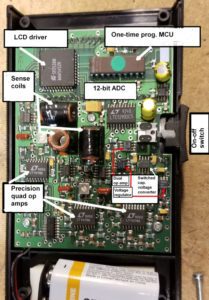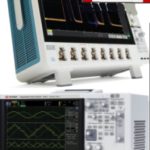Tune in to TV shows that are purportedly about ghost hunting and you’ll often see people wandering around in the dark with an instrument called a milligauss meter. A milligauss meter detects changing magnetic fields. (It won’t detect static fields as from a bar magnet.) When a milligauss meter shows a reading during a ghosting hunting video, there’s usually a lot of excitement on screen. The implication is that somehow, spirits generate magnetic fields that the meter can pick up.
Typically, the ghost hunting expeditions seen on YouTube and TV aren’t carried out according to the scientific method. For one thing, real scientists might point out that there is no control experiment. In other words, would you get the same kinds of readings in an ordinary “non-haunted” house?
That was our motivation for spending time recently wandering around in a darkened house with a milligauss meter. There is nothing special about the house we chose as far as we know. Built in the mid 1950s, it sits in an ordinary suburb. It is situated 100 ft away or more from the power lines supplying the street and about 200 ft away from the nearest building, distant enough that typical household magnetic fields generated by the neighbors would not be a factor.

Videos featuring ghost hunting expeditions often use milligauss meters incorporating LEDs that light up when the reading exceeds a certain level, perhaps to add visual interest because there usually isn’t much going on during these quests. It’s easy to find these meters on Amazon going for well less than $100. One we spotted online was claimed to cover the 50-20,000 Hz range and was advertised with an accuracy of 5% at 50-60 Hz.
A couple of comments: The meter in question registers fields by lighting up one of five LEDs depending on field strength. But the span for each of the five ranges is different. The lowest range covers up to 1.5 mG, the second covers a 1-mG range, the third a 7.5-mG range, the fourth a 10-mG range, while the fifth lights up for 20 mG and above. One wonders how the 5% accuracy is calculated given that, say, a 3 mG field will register the same as a 9 mG field. The claim of operation to 20 kHz is also interesting. Most instrument-grade milligauss meters in the $100 price range measure fields up to a few hundred hertz at most. Those able to handle higher frequencies tend to be pricey–$500 for a milligauss meter able to measure fields in the tens of kilohertz is not unusual.

Eyeballing typical magnetic sensors able to register fields in the 20 kHz range shows why milligauss meters handling these frequencies tend to command a higher price. It is not unusual for the sensor alone to go for over $100.
The milligauss meter we used is LED-less but more accurate than those typically featured in ghost hunting videos. Made by Teslatronics in Calif., it lists an accuracy of ±1% typical for levels exceeding 10 mG. It also has directionality thanks to its use of three orthogonal sense coils. It has a frequency response that is flat out to 400 Hz with a -3 dB span from 30 to 600 Hz. Prior to us receiving it, the meter was calibrated to a lab standard directly traceable to NIST.

Our meter was manufactured back in the days when operator manuals often included a circuit description, so we know how the Teslatronics meter functions. It contains three independent amplifier/detection chains for each of the three air-coil sensors. A buffered ac voltage from each sensor gets converted to dc which is scaled to indicate the rms value of the magnetic field. A four-channel ADC converts the analog dc voltages to a 12-bit word for display on the LCD. (The fourth ADC channel is for sensing battery voltage.)

We took a look at the meter PCB to get a bit more insight into its functions. The amplifier/detector chain op amps take the form of precision quad op-amp ICs (LT1079) from Linear Technology, now Analog Devices. The 12-bit ADC is also a Linear/Analog Devices part (LTC1290). The MPU (COP8782) is an eight-bit one-time programmable device from National Semiconductor, now Texas Instruments. TI also makes the LCD driver (MM5452V). The remaining ICs include dual op amps, voltage regulators, voltage converters, a three-channel analog multiplexor, and a reference buffer for the ADC that are all either TI or AD parts.
One of the criticisms of ghost hunting-type videos is that readings on milligauss meters are easily manipulated. We illustrated one way that can happen while we stumbled through the dark house. At one point we were in a room that contained a WiFi router. A lot of electronics, including routers, generate magnetic fields. So if we wanted to film a scene where the milligauss meter went crazy, we could just walk near the WiFi router and keep it out of frame so viewers can’t see it. In our case, we got readings of 30 mG and more as we came within a couple feet of the WiFi hotspot.
More generally, ordinary household appliances can give off magnetic fields in the low double-digit or high single-digit milligauss range. For example, electric ranges and microwave ovens can emit up to about 7 mG detectable from a few feet away. Another issue concerns the video cameras and wireless mics used to film videos. Being electronic devices, they can also be sources of magnetic fields, as can LED lights sometimes employed to keep participants to from tripping over household objects. Many LED lights get power from built-in switching supplies. If the supply shielding isn’t first rate, it, too, can generate a few milligauss.
For our own ghost quest, we tried to minimize the magnetic field contribution from personal electronics by ditching all our cell phones and other electronic devices that weren’t absolutely necessary for shooting video. That still left us with video cameras and mics, of course. And we found that electrification does indeed affect magnetic field readings. After wandering around in the dark for a while with the house power on, we switched off all the house circuits at the breaker panel. The most evident change was an immediate drop in the level of background milligauss readings. With house power on, it was not unusual to see the Teslatronics meter read out a few milligauss as we went from room to room. With house power completely off, those background readings dropped to about one milligauss or less.
To summarize what happened during our travels within the house, nothing much occurred. The biggest hazard was the possibility of tripping over furniture in the dark rather than being pranked by some kind of spirit. Occasionally we were able to get milligauss readings high enough to set off the meters commonly seen on searching-for-ghost-type videos. It was certainly easier to get such readings with the house power on. With house power off, we only noticed one or two times when readings might have actuated the LEDs on the meters commonly used in spirit-quest videos.
We have no idea how long people who make haunted house videos actually have to hang out in the house to get the footage they show. We suspect that time may be measured in multiple hours. In our case, we got bored with the whole experiment after about an hour of nothing much happening. And with house power off we had no A/C, which made the proceedings increasingly steamy on what turned out to be a warm night. In that regard, we could be criticized for giving up on our little experiment before the traditional witching hour.
On the other hand, we didn’t think spending more time fumbling around in the dark would give us a ghost of a chance of seeing anything interesting.






Leave a Reply
You must be logged in to post a comment.